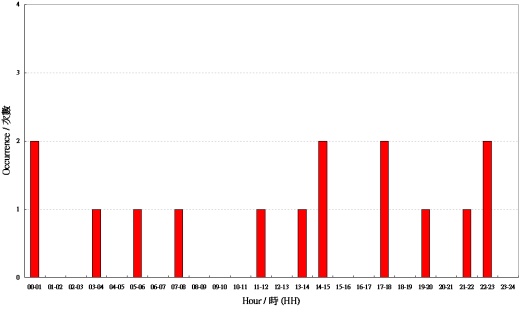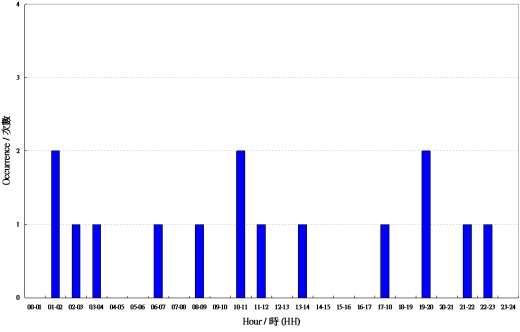A question about typhoon signals
11 February 2011
A question people often ask is whether the Observatory has economic considerations in mind when considering the hoisting and lowering of tropical cyclone signals.
The best way to answer it is to look at the past record of tropical cyclone signals.
From 1997 to 2010, a total of 67 tropical cyclones (TC) came close enough to warrant the issuance of TC signals. Of these, 20 necessitated the hoisting of the No. 8 Gale or Storm Signal or above, which for most people in Hong Kong means no work and no school.
Of the 20 occasions, 15 (75%) occurred on a work day, while the remaining 5 (25%) occurred on weekends and public holidays. These 15 cases resulted in school closures on 13 days, and closure of the stock market for 4 full days and 8 half days (i.e. whole or part of the morning or afternoon). Information about closures of schools and the stock market is based on press reports. It should be noted that a No. 8 or higher signal that has been hoisted or remains hoisted in the early morning may affect the opening or closure of schools and the stock market that day, even though the signal may be lowered subsequently.
Now let's look at the hoisting and lowering times of these 15 cases. Figure 1 shows the time of day when the No. 8 Signal was hoisted. Figure 2 is the same as Figure 1, but for the signal lowering time. All told, these figures do not seem to suggest there is a tendency for the hoisting and lowering of the No. 8 signal to avoid work hours or school hours.

Figure 1Distribution of hoisting time of the No. 8 Signal on a work day, 1997-2010.

Figure 2Same as Figure 1, but for signal lowering time.
People often say 'weather knows no boundary'. It may also be true that weather knows no time constraints. Ultimately, it is public safety that matters.
B.Y. Lee and H.Y. Mok
The best way to answer it is to look at the past record of tropical cyclone signals.
From 1997 to 2010, a total of 67 tropical cyclones (TC) came close enough to warrant the issuance of TC signals. Of these, 20 necessitated the hoisting of the No. 8 Gale or Storm Signal or above, which for most people in Hong Kong means no work and no school.
Of the 20 occasions, 15 (75%) occurred on a work day, while the remaining 5 (25%) occurred on weekends and public holidays. These 15 cases resulted in school closures on 13 days, and closure of the stock market for 4 full days and 8 half days (i.e. whole or part of the morning or afternoon). Information about closures of schools and the stock market is based on press reports. It should be noted that a No. 8 or higher signal that has been hoisted or remains hoisted in the early morning may affect the opening or closure of schools and the stock market that day, even though the signal may be lowered subsequently.
Now let's look at the hoisting and lowering times of these 15 cases. Figure 1 shows the time of day when the No. 8 Signal was hoisted. Figure 2 is the same as Figure 1, but for the signal lowering time. All told, these figures do not seem to suggest there is a tendency for the hoisting and lowering of the No. 8 signal to avoid work hours or school hours.

Figure 1Distribution of hoisting time of the No. 8 Signal on a work day, 1997-2010.

Figure 2Same as Figure 1, but for signal lowering time.
People often say 'weather knows no boundary'. It may also be true that weather knows no time constraints. Ultimately, it is public safety that matters.
B.Y. Lee and H.Y. Mok